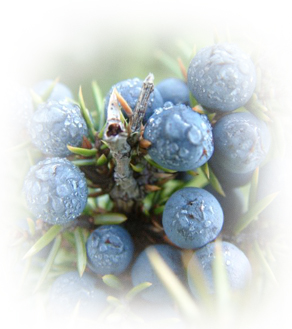Juniper
|
|
| Juniperus spp Cupressaceae
In Grimm’s fairy tales “The Juniper Tree” depicts the tale of a women dying in childbirth after ingesting copious amounts of juniper berries. A rather grim fairy tale but the warning is true, the counter indication is that the berries can cause cramping during pregnancies. Used throughout history, the branches were burned during childbirth to prevent the fairies from substituting a changeling for the newborn. Ancient Greek physicians would cure snake bites and purify the homes affected by illness and death. During the Middle Ages it was believed that the smoke from burning the branches would protect against infectious diseases like the plague and leprosy. The name “gin” is derived from the French “genièvre” and /or the Dutch “jenever” both referring to the English “juniper” |
|
|
In the Garden
Depending on the species the smell can be quite pungent or quite citrusy; for the berries the taste varies from species to species. To ensure a female specimen choose one with berries when purchasing. Juniperus communis Common juniper is traditionally the choice for medicinal herbs and can grow in the worst soil conditions, dry, waste lands, neutral or acidic. Wind tolerant but not as heat tolerant as J. chinensis, which prefers clay soil and is found in the Ottawa area. Taste is personal –Juniperus chinensis ‘Mountbatten’ an upright, dense, pyramidal growing to 12 feet is my choice after tasting a variety of berries and having heavy clay soil in my garden. The male flowers are very small catkins; the female flowers are small, globose and berry like with fleshy scales. The berries at first are whitish blue and will ripen over a period of 18 months to 3 years to a darker blue. Junipers may cause contact dermatitis. They rarely need pruning but will tolerate it well. When shopping for a plant read the labels: these usually indicate height, spread and will have 2 sets of numbers (minimum and maximum height) (minimum and maximum width) respect the numbers and you will not have to move the plant in five years. |
|



